第二讲 基本句型的转换与扩大 主谓一致(一)
- 格式:doc
- 大小:29.00 KB
- 文档页数:2

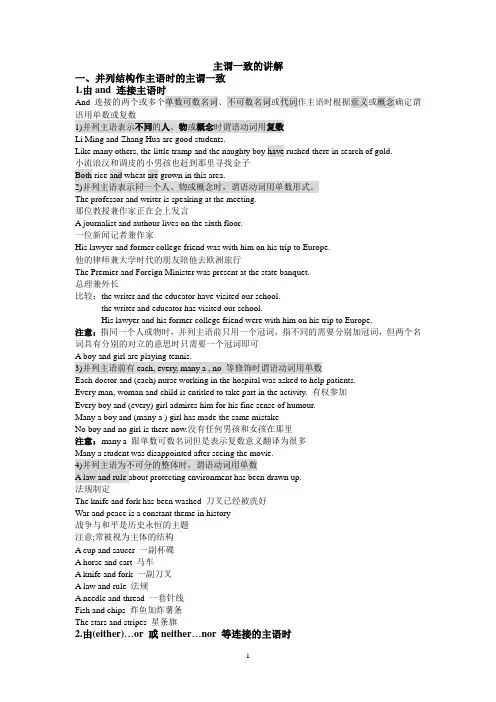
主谓一致的讲解一、并列结构作主语时的主谓一致1.由and 连接主语时And 连接的两个或多个单数可数名词、不可数名词或代词作主语时根据意义或概念确定谓语用单数或复数1)并列主语表示不同的人、物或概念时谓语动词用复数Li Ming and Zhang Hua are good students.Like many others, the little tramp and the naughty boy have rushed there in search of gold.小流浪汉和调皮的小男孩也赶到那里寻找金子Both rice and wheat are grown in this area.2)并列主语表示同一个人、物或概念时,谓语动词用单数形式。
The professor and writer is speaking at the meeting.那位教授兼作家正在会上发言A journalist and authour lives on the sixth floor.一位新闻记者兼作家His lawyer and former college friend was with him on his trip to Europe.他的律师兼大学时代的朋友陪他去欧洲旅行The Premier and Foreign Minister was present at the state banquet.总理兼外长比较:the writer and the educator have visited our school.the writer and educator has visited our school.His lawyer and his former college friend were with him on his trip to Europe.注意:指同一个人或物时,并列主语前只用一个冠词,指不同的需要分别加冠词,但两个名词具有分别的对立的意思时只需要一个冠词即可A boy and girl are playing tennis.3)并列主语前有each, every, many a , no 等修饰时谓语动词用单数Each doctor and (each) nurse working in the hospital was asked to help patients.Every man, woman and child is entitled to take part in the activity. 有权参加Every boy and (every) girl admires him for his fine sense of humour.Many a boy and (many a ) girl has made the same mistakeNo boy and no girl is there now.没有任何男孩和女孩在那里注意:many a 跟单数可数名词但是表示复数意义翻译为很多Many a student was disappointed after seeing the movie.4)并列主语为不可分的整体时,谓语动词用单数A law and rule about protecting environment has been drawn up.法规制定The knife and fork has been washed 刀叉已经被洗好War and peace is a constant theme in history战争与和平是历史永恒的主题注意;常被视为主体的结构A cup and saucer 一副杯碟A horse and cart 马车A knife and fork 一副刀叉A law and rule 法规A needle and thread 一套针线Fish and chips 炸鱼加炸薯条The stars and stripes 星条旗2.由(either)…or 或neither…nor 等连接的主语时由either…or, neither…nor, or, not only…but(also)…连接主语时,谓语动词陈述句中就近原则Either you or Jane is to be sent to New York.要么你要么简被派往纽约Neither you nor he has finished the experiment.Neither the teacher nor the students like this piece of music. 都不喜欢这首曲子Not only the old farmer but also his family were friendly to me.Not only his friends but also he himself is looking forward to taking part in the party.3.主语由肯定否定两部分构成谓语跟肯定部分走Not you but I am to answer the questionI, not you, am to answer the question.二、单一主语的主谓一致1.名词本身自带s作主语时1)学科名词: physics 物理mathematics/maths 数学economics 经济学politics政治学新闻; news体操:GymnasticsAs we know, Physics is a fundamental subject in science.物理是自然科学中的一门基础学科Mathematics is a required course for middle school students.数学是中学生的一门必修课Einstein once said ,“Politics is much more difficult than physics.”注意:当mathematics 表示运算时谓语动词用单数复数都可If my mathematics is/are right, the answer is 56.如果我的运算正确,答案就是56The television news is at 7 o’clock in the evening every dayGymnastics is my sister’s favourite sport2)有些名词单复数同行根据是单数概念还是复数概念判断谓语means方式方法aircraft 飞机works 工厂crossroads十字路口deer 鹿sheep 羊fish 鱼This works was build in 1982 这座工厂是By far, three steelworks have been closed down in this cityThis means of transport has been triedAll possible means have been tried3)由两部分组成的物体名词作主语时,谓语动词用复数chopsticks筷子compasses 圆规glasses眼镜gloves手套Jeans牛仔裤pants裤子scissors剪子shoes鞋子shorts短裤socks短袜trousers裤子My trousers are white and his clothes are black.我的裤子是白色的他的衣服是黑色的Why are your shoes so dirty?注意;如果这些词由单位词(a pair of , a suit of , a piece of , a kind of 等)修饰时,单位词的单复数决定谓语动词的单复数A pair of scissors is lying in that drawer.These kinds of glasses are popular this summer.4)表示国家、人名、书名、组织机构等的专有名词作主语时,谓语动词用单数The united States is a developed countryThe New York Times is widely read in the world.5)以-s 结尾的群岛、山脉、海峡、瀑布等专有名词谓语动词用复数The Himalayas have a magnificent variety of plants.植物种类繁多The Niagara Falls are splendid waterfalls.6)以-S结尾的名词作主语时谓语动词用复数He doesn’t eat much fruit. 他不大吃水果.He is growing fruit in the country. 他在乡下种水果.但是,当要表示种类时,它可视为可数名词,即a fruit 指一种水果,fruits 指多种水果.比较:Some fruits have thick skins. 有些水果皮很厚.3.非谓语动词或从句作主语时1)非谓语动词或从句作主语时谓语动词用单数To improve agricultural land needs a lot of money.改善耕地质量需要投入大量的资金To see is to believeSwimming is a good way to keep healthHow they will solve the problem remains to be seenWhether she will come is not known2)多个非谓语动词作主语,表达一个概念谓语用单数,表达不同概念谓语用复数Going to be early and getting up early is good for your health.早睡早起一个概念Reading books and playing table tennis are my great pleasure.读书和打乒乓球Listening, speaking, reading and writing are all important.To be strict with oneself and to be kind to others are good qualities of a person三、其他情况的主谓一致1.表示距离、时间、长度、金额、质量等的复数名词作主语时常被看作是整体谓语动词用单数这类复数名词有:miles, dollars, pounds, kilograms公斤千克, kilometres公里, centimetres,厘米millimetres毫米, seconds, hours, years等Five dollars seems a fair price 是一个公道的价格Two kilometres is not very far for the young manFive hours is a short time for such a difficult job2.如果强调数目谓语动词用复数One hundred cents make a dollarMore than twenty years have passed since they got married.3.算数中的谓语动词一般用单数形式,有时也用复数Five times eight is/are fortyFour and eight makes/make twelveSixty minus seven leaves fifty-threeForty-eight divided by six is eight4.复合不定代词作主语时谓语动词用单数Everyone something anybody nowhereEveryone in the class was surprised at the newsListen! Someone is knocking at the door.Is anyone going to tell him the news?5.each one of…, every one of …, anyone of…, one of…, 等作主语时谓语用单数Each of the girl in our class has a balloon 我们班每个女孩都有一个气球Each of the students was asked to speak for three minutes.Every one of them is familiar to me. 我对他们都很熟悉6.each , every 作形容词修饰主语时谓语动词用单数但是each 作复数主语的同位语时谓语用复数Each/Every boy in our class has a skateboard一副滑板They each have a stateboardEach/Every student has an English-Chinese dictionaryThe students each have an English-Chinese dictionary7.none of + 不可数名词谓语用单数none of,neither of, + 可数名词复数/复数代词+ 谓语动词单数复数都可either of ,None of that money in the desk is his 不可数名词None of his classmates knows the truth.= None of his classmates know the truthNeither of the statements is true = Neither of the statements are true 两种说法没有一个真实Either of the qualifications is acceptable = Either of the qualifications are acceptable8.neither 与either 做形容词修饰单数名词时谓语动词用单数Either qualification is acceptable两种资格中的任何一种都可以接受Neither qualification is acceptable9.分数百分数+ of + 名词,some of , plenty of, a lot of, lots of, most of, the rest of, all(of), half(of) 谓语常与of 后面的名词一致分数/百分数+ of + 复数名词/ 复数代词谓语动词用复数分数/百分数+ of + 单数名词/单数代词谓语动词用单数不可数名词Two thirds of the students support the plan复数名词One tenth of them are suffering from this kind of illness.复数代词Three fourths of the surface of the earth is sea单数名词Eighty percent of the employees in the company are from Beijing百分数复数名词Thirty percent of its area is flooded each year.百分数单数名词The rest of the money belongs to youThe rest of the students speak for it.Half of the apple is rottenHalf of the apples are rotten10.more(…) than one…结构作主语时More(…)than one…+ 单数名词谓语用单数More + 复数名词+ than one 谓语用复数More than two + 复数名词谓语用复数More than one white rose has bloomed in the gardenMore white roses than one have bloomed in the gardenMore than two white roses have bloomed 两个以上的的白玫瑰开了11.a number of + 复数名词谓语用复数许多的The number of + 名词谓语动词用单数…的数量A number of trees are green in AprilA great number of tourists have been to the Great WallA large number of worker were out of work because the factory was destroyed in flood.The number of students in the computer class is limited to ten.The number of workers who were out of work was 1,000.12.there/here…引导句子时就近原则There are some chairs and a table in the roomThere is a table and some chairs in the roomHere are some gifts for youHere is a book, a pen and some paper for you.13.当主语后接修饰语时With, along with, together with, but, besides, except, like, including, in addition to, as well as, rather than, 谓语动词与前面的主语保持一致A library with five thousand books is offered to the nation as a gift被作为礼物送给了这个国家The teacher, along with her students, is going to attend the lecture 听报告A peasant, together with some soldiers, is about to help us.All but one have arrived here.除了一个人外所有人都到了No one except two students was late for class.再没有其他人上课迟到The garage, in addition to the house, was burned.She as well as the other girls is going to another supermarked.You as well as I are wrong.The father, rather than the brother, is responsible.父亲而不是兄弟们应当负责14.The+ 形容词做主语时表示一类人用复数谓语表示抽象概念用单数谓语The injured were carried away on stretchers.用担架抬走了The old are more likely to catch cold than the youngThe rich are for the decision but the poor are against it.The young are always full of vitality充满了活力The unknown is always something to be feared 未知的东西总是令人害怕The beautiful is not always the good, and the good is not always the true.美未必是善善未必是真The true is to be distinguished from the false真应与假相区别The good is what people like 人们总是喜欢美好的东西In many stories, the good are well rewarded and the bad are punished.好人有好报坏人有怀抱15.all做主语时指一切表示单数概念用单数谓语,指具体人或物用复数谓语All has been tried一切都试过了All were silent 大家都一言不发All was silent 万籁俱寂All are here now 大家都在16.由a kind of, this kind of, many kinds of, 名词+of this kind, a type of a sort of 谓语动词根据of 后面的名词来定A new type of machine is on show now.Machines of this kind are made in Wuhan。
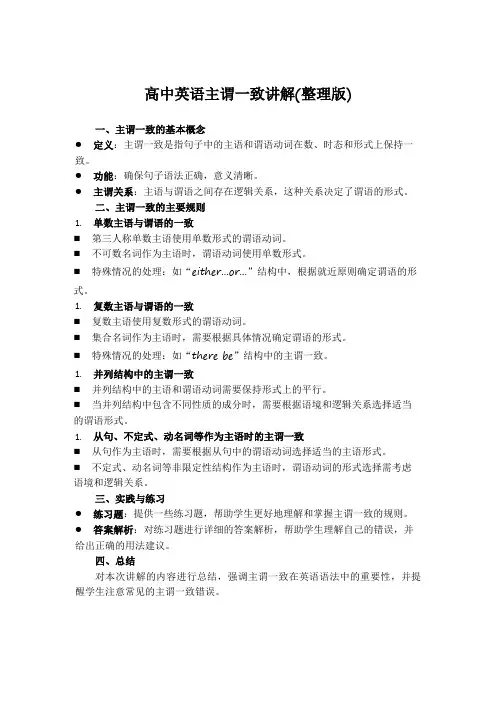
高中英语主谓一致讲解(整理版)
一、主谓一致的基本概念
●定义:主谓一致是指句子中的主语和谓语动词在数、时态和形式上保持一致。
●功能:确保句子语法正确,意义清晰。
●主谓关系:主语与谓语之间存在逻辑关系,这种关系决定了谓语的形式。
二、主谓一致的主要规则
1.单数主语与谓语的一致
⏹第三人称单数主语使用单数形式的谓语动词。
⏹不可数名词作为主语时,谓语动词使用单数形式。
⏹特殊情况的处理:如“either...or...”结构中,根据就近原则确定谓语的形式。
1.复数主语与谓语的一致
⏹复数主语使用复数形式的谓语动词。
⏹集合名词作为主语时,需要根据具体情况确定谓语的形式。
⏹特殊情况的处理:如“there be”结构中的主谓一致。
1.并列结构中的主谓一致
⏹并列结构中的主语和谓语动词需要保持形式上的平行。
⏹当并列结构中包含不同性质的成分时,需要根据语境和逻辑关系选择适当的谓语形式。
1.从句、不定式、动名词等作为主语时的主谓一致
⏹从句作为主语时,需要根据从句中的谓语动词选择适当的主语形式。
⏹不定式、动名词等非限定性结构作为主语时,谓语动词的形式选择需考虑语境和逻辑关系。
三、实践与练习
●练习题:提供一些练习题,帮助学生更好地理解和掌握主谓一致的规则。
●答案解析:对练习题进行详细的答案解析,帮助学生理解自己的错误,并给出正确的用法建议。
四、总结
对本次讲解的内容进行总结,强调主谓一致在英语语法中的重要性,并提醒学生注意常见的主谓一致错误。
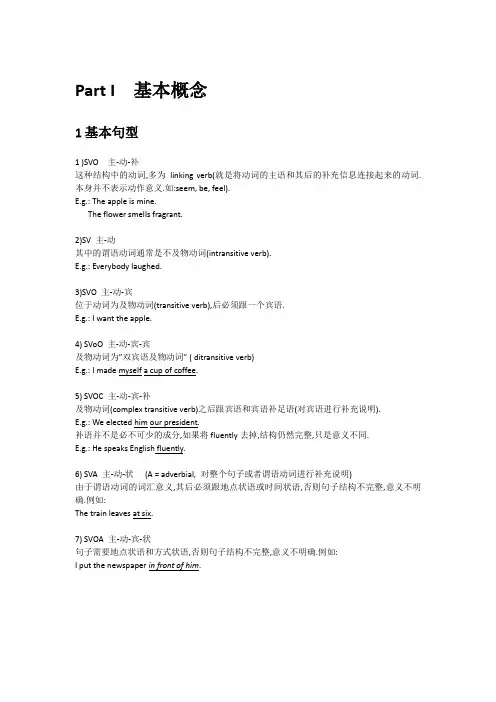
Part I 基本概念1基本句型1 )SVO 主-动-补这种结构中的动词,多为linking verb(就是将动词的主语和其后的补充信息连接起来的动词.本身并不表示动作意义.如:seem,be,feel).E.g.: The apple is mine.The flower smells fragrant.2)SV 主-动其中的谓语动词通常是不及物动词(intransitive verb).E.g.: Everybody laughed.3)SVO 主-动-宾位于动词为及物动词(transitive verb),后必须跟一个宾语.E.g.: I want the apple.4) SVoO 主-动-宾-宾及物动词为”双宾语及物动词”(ditransitive verb)E.g.: I made myselfa cup of coffee.5) SVOC 主-动-宾-补及物动词(complex transitive verb)之后跟宾语和宾语补足语(对宾语进行补充说明).E.g.: We elected himour president.补语并不是必不可少的成分,如果将fluently去掉,结构仍然完整,只是意义不同.E.g.: He speaks English fluently.6) SVA 主-动-状(A = adverbial, 对整个句子或者谓语动词进行补充说明)由于谓语动词的词汇意义,其后必须跟地点状语或时间状语,否则句子结构不完整,意义不明确.例如:The train leaves at six.7) SVOA 主-动-宾-状句子需要地点状语和方式状语,否则句子结构不完整,意义不明确.例如:I put the newspaper in front of him.核心句型by Zellig Harriswhere: P = preposition; V b = link verb; and A = attributive2基本句型的转换和扩大转换:由陈述句变疑问句,否定句,强调句etc扩大:1)分句的并列例如He has gone to England and he studies literature there.2) 增加修饰成分和只用从属分句.即使用从属分句来使表达的思想复杂化.如:We have come into an agreement in how should we treat our children and educate them.并列和从属两种手段也可以重复使用. 例如:He (a successful scientist) is not only critical of the work of others, but also of his own, since he knows that man is the least reliable of scientific instruments and that a number of factors tend to disturb impartial and objective investigation.扩展句子:Birds fly.Part II 主谓一致主谓一致是指主语和谓语动词在”人称”和”数”的方面的一致关系.(汉语并不要求主谓一致.) 1指导原则1.语法一致原则Grammatical Concord主语和谓语之间的一致性主要表现在”数”上,即用作主语的名词词组的中心词和谓语动词在单数和复数形式上的一致.例如:Every girl comes well dressed.Two girls are eating ice cream.2.意义一致notional concord有时,语法形式上的单复数,并不表示意义上的单复数,此时主谓一致关系则取决于主语的单复数意义.如:主语在语法形式上不是复数,但表示复数意义,则谓语动词要用复数(当government表示组成其的成员时),主语在形式上是复数,但是意义可视为单数,则谓语动词相应用单数.这种一致关系就叫做意义一致.例如:Five miles seems quite a long walk to Japanese.The team have been arguing about the matter.3.就近原则principle of proximity当谓语动词的单复数取决于最靠近它的词语(主要指名词)的单复数形式,此时的一致关系所依据的原则就叫做”就近原则”.例如:Either my brothers or my sister is coming.2.特殊结构或词语的主谓一致1.以-s结尾的地理名称若为国名,如the United States, the Netherlands等,为单一政治体,谓语动词用单数.如:The United States is a melting pot of varied cultures.若为山脉.群岛,海峡等地理名称,则用复数动词:The Himalayas have a magnificent variety of plants.2.以-ics结尾的学科名词如mathematics,physics用单数.但是当这类名词表示”学科”以外的意义时,便做复数用.如,economics 表示经济意义,athletics 表示体育运动.例如:The acoustics(音响效果) in the new concert hallare faultless.3.以集体名词做主语的主谓一致问题集体名词(collective noun),如government, committee, team, group等,在形式上是单数,但是在意义上是复数.以这类名词做主语的主谓一致问题往往在于对”语法一致”和”意义一致”两种原则的选择.其规则为:1)通常用作复数的集体名词,如police, people, cattle等,其后的动词要用复数.例如:Domestic cattle provide us with milk and beef.2)通常做不可数名词的集体名词.如foliage, machinery, equipment, furniture等,其后的动词要用单数.例如:All the machinery in the factory is made in China.3)即可做单数又可做复数的集体名词.如class, audience, group, team, family等,当将其集体视为一个整体时,动词用单数.若将侧重点放在组成的成员上时,动词用复数,例如:The city council is meeting to set its agenda.The city council are talking about its agenda in groups of two or three4) a committee of 等+ 复数名词当主语由“a committee of/a panel of/a(the) board of+复数名词”构成,其后的谓语动词用单数:例如:A committeeof five men and three women is working on matter. (由五个男人和三个女人组成的committee,是committee作为一个整体)4. 以并列结构为主语的主谓一致问题1)由and/both···and连接的并列主语A)如果意义是单数,用单数谓语动词The secretary and treasurer is absent. (两个职位均由同一个人担任)B)如果意义是复数,则谓语动词用复数The secretary and the treasurer are absent.特殊情况:有一些由and连接的结构形似单数,实则为复数,此时动词用复数:如:Good and bad taste are inculcated by example.What I say and think are none of your business.当and 连接的并列名次词组带有each,every,或者many a等限定词时,随后的动词常用单数。
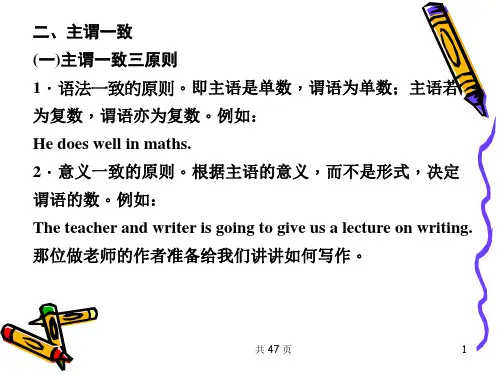
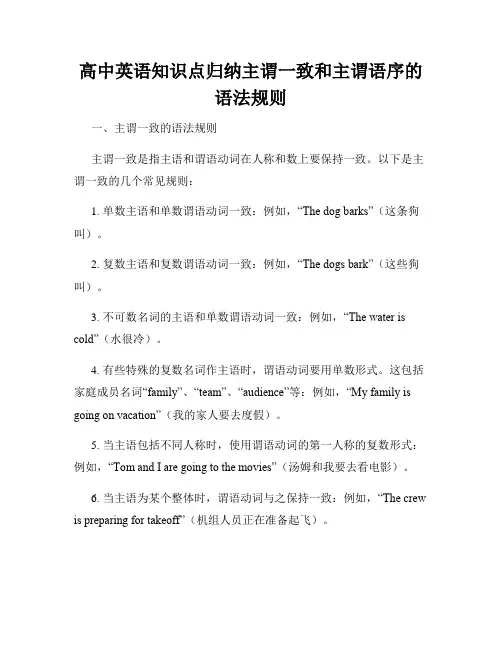
高中英语知识点归纳主谓一致和主谓语序的语法规则一、主谓一致的语法规则主谓一致是指主语和谓语动词在人称和数上要保持一致。
以下是主谓一致的几个常见规则:1. 单数主语和单数谓语动词一致:例如,“The dog barks”(这条狗叫)。
2. 复数主语和复数谓语动词一致:例如,“The dogs bark”(这些狗叫)。
3. 不可数名词的主语和单数谓语动词一致:例如,“The water is cold”(水很冷)。
4. 有些特殊的复数名词作主语时,谓语动词要用单数形式。
这包括家庭成员名词“family”、“team”、“audience”等:例如,“My family is going on vacation”(我的家人要去度假)。
5. 当主语包括不同人称时,使用谓语动词的第一人称的复数形式:例如,“Tom and I are going to the movies”(汤姆和我要去看电影)。
6. 当主语为某个整体时,谓语动词与之保持一致:例如,“The crew is preparing for takeoff”(机组人员正在准备起飞)。
7. 当主语中包括“each”、“every”、“either”、“neither”、“everyone”、“nobody”等词时,谓语动词用单数形式:例如,“Every student has to submit their homework”(每个学生都必须提交他们的作业)。
二、主谓语序的语法规则主谓语序指的是主语和谓语动词的顺序要保持一致。
以下是主谓语序的几个常见规则:1. 在陈述句中,主语通常位于谓语动词之前:例如,“She is a teacher”(她是一名老师)。
2. 在疑问句中,将谓语动词放在主语之前:例如,“Are you hungry?”(你饿了吗?)。
3. 在祈使句中,主语通常省略,谓语动词单独出现:例如,“Sit down”(坐下)。
4. 在条件句中,主语通常位于谓语动词之前:例如,“If it rains, we will stay indoors”(如果下雨,我们就呆在室内)。
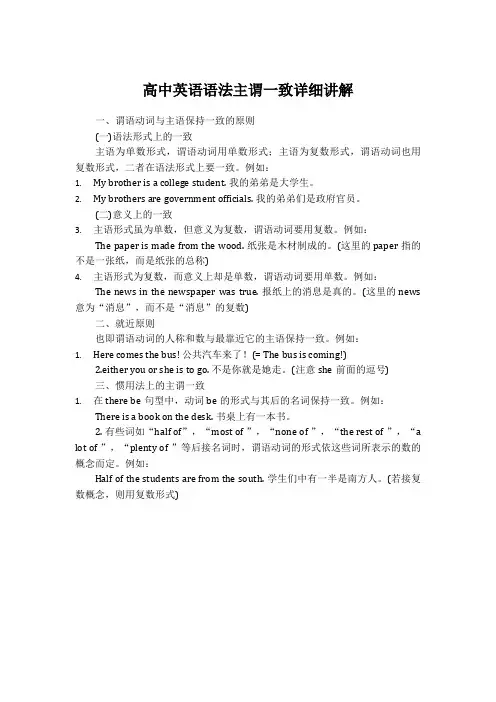
高中英语语法主谓一致详细讲解一、谓语动词与主语保持一致的原则(一)语法形式上的一致主语为单数形式,谓语动词用单数形式;主语为复数形式,谓语动词也用复数形式,二者在语法形式上要一致。
例如:1.My brother is a college student. 我的弟弟是大学生。
2.My brothers are government officials. 我的弟弟们是政府官员。
(二)意义上的一致3.主语形式虽为单数,但意义为复数,谓语动词要用复数。
例如:The paper is made from the wood. 纸张是木材制成的。
(这里的paper 指的不是一张纸,而是纸张的总称)4.主语形式为复数,而意义上却是单数,谓语动词要用单数。
例如:The news in the newspaper was true. 报纸上的消息是真的。
(这里的news 意为“消息”,而不是“消息”的复数)二、就近原则也即谓语动词的人称和数与最靠近它的主语保持一致。
例如:1.Here comes the bus! 公共汽车来了!(= The bus is coming!)2.either you or she is to go. 不是你就是她走。
(注意she前面的逗号)三、惯用法上的主谓一致1.在there be句型中,动词be的形式与其后的名词保持一致。
例如:There is a book on the desk. 书桌上有一本书。
2. 有些词如“half of”,“most of ”,“none of ”,“the rest of ”,“a lot of ”,“plenty of ”等后接名词时,谓语动词的形式依这些词所表示的数的概念而定。
例如:Half of the students are from the south. 学生们中有一半是南方人。
(若接复数概念,则用复数形式)。
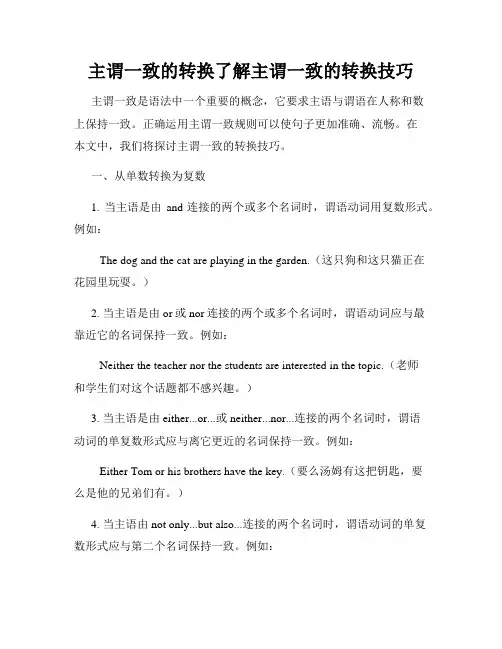
主谓一致的转换了解主谓一致的转换技巧主谓一致是语法中一个重要的概念,它要求主语与谓语在人称和数上保持一致。
正确运用主谓一致规则可以使句子更加准确、流畅。
在本文中,我们将探讨主谓一致的转换技巧。
一、从单数转换为复数1. 当主语是由and连接的两个或多个名词时,谓语动词用复数形式。
例如:The dog and the cat are playing in the garden.(这只狗和这只猫正在花园里玩耍。
)2. 当主语是由or或nor连接的两个或多个名词时,谓语动词应与最靠近它的名词保持一致。
例如:Neither the teacher nor the students are interested in the topic.(老师和学生们对这个话题都不感兴趣。
)3. 当主语是由either...or...或neither...nor...连接的两个名词时,谓语动词的单复数形式应与离它更近的名词保持一致。
例如:Either Tom or his brothers have the key.(要么汤姆有这把钥匙,要么是他的兄弟们有。
)4. 当主语由not only...but also...连接的两个名词时,谓语动词的单复数形式应与第二个名词保持一致。
例如:Not only the students but also the teacher is going to the field trip.(不仅学生们要去野外旅行,老师也要去。
)二、从复数转换为单数1. 当主语是以each, every, either, neither等为代词的复数名词时,谓语动词应用单数形式。
例如:Each of the students has a different opinion.(每个学生都有不同的观点。
)2. 当主语是以many a, a number of, a lot of, a great deal of等短语修饰的复数名词时,谓语动词应用单数形式。

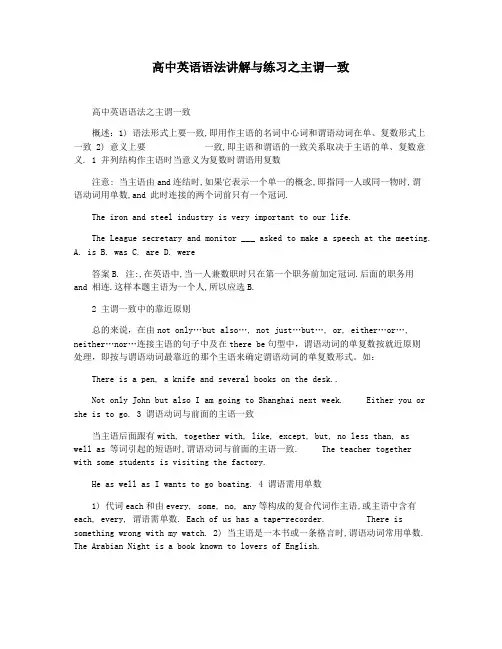
高中英语语法讲解与练习之主谓一致高中英语语法之主谓一致概述:1) 语法形式上要一致,即用作主语的名词中心词和谓语动词在单、复数形式上一致 2) 意义上要一致,即主语和谓语的一致关系取决于主语的单、复数意义. 1 并列结构作主语时当意义为复数时谓语用复数注意: 当主语由and连结时,如果它表示一个单一的概念,即指同一人或同一物时,谓语动词用单数,and 此时连接的两个词前只有一个冠词.The iron and steel industry is very important to our life.The League secretary and monitor ___ asked to make a speech at the meeting.A. isB. wasC. areD. were答案B. 注:,在英语中,当一人兼数职时只在第一个职务前加定冠词.后面的职务用and 相连.这样本题主语为一个人,所以应选B.2 主谓一致中的靠近原则总的来说,在由not only…but also…, not just…but…, or, either…or…, neither…nor…连接主语的句子中及在there be句型中,谓语动词的单复数按就近原则处理,即按与谓语动词最靠近的那个主语来确定谓语动词的单复数形式。
如:There is a pen, a knife and several books on the desk..Not only John but also I am going to Shanghai next week. Either you or she is to go. 3 谓语动词与前面的主语一致当主语后面跟有with, together with, like, except, but, no less than, aswell as 等词引起的短语时,谓语动词与前面的主语一致. The teacher togetherwith some students is visiting the factory.He as well as I wants to go boating. 4 谓语需用单数1) 代词each和由every, some, no, any等构成的复合代词作主语,或主语中含有each, every, 谓语需单数. Each of us has a tape-recorder. There is something wrong with my watch. 2) 当主语是一本书或一条格言时,谓语动词常用单数. The Arabian Night is a book known to lovers of English.3) 表示金钱,时间.距离.价格或度量衡的复合名词作主语时,通常把这些名词看作一个整体,谓语一般用单数. Three weeks was allowed for making the necessary preparations. Ten yuan is enough.5 指代意义决定谓语的单复数 1) 在代词what, which, who, none, some, any, more, most, all等词的单复数由其指代的词的单复数决定. All is right. (一切顺利.) All are present. (所有人都到齐了.)2) 集体名词作主语时,谓语的数要根据主语的意思来决定.如family, audience, crew, crowd, class, company, committee等词后用复数形式时,意为这个集体中的各个成员,用单数时表示该个集体. His family isn't very large. 他家不是一个大家庭.His family are music lovers. 他的家人都是音乐爱好者.但集合名词people, police, cattle, poultry(家禽).militia(民兵).vermin等在任何情况下都用复数形式. Are there any police around3)有些名词,如variety, number, population, proportion, majority 等有时看作单数,有时看作复数. A number of +名词复数+复数动词. The number of +名词复数+单数动词.A number of books have lent out. The majority of the students like English.6 与后接名词或代词保持一致1) 用half of, part of, most of, a portion of 等词引起主语时,动词通常与of后面的名词,代词保持一致. Most of his money is spent on books.Most of the students are taking an active part in sports.2) 在一些短语,如 many a 或 more than one 所修饰的词作主语时,谓语动词多用单数形式.但由more than… of 作主语时,动词应与其后的名词或代词保持一致.Many a person has read the novel. 许多人都读过这本书.More than 60 percent of the students are from the city.百分之六十多的学生都来自这个城市.主谓一致中的\表里不一\现象和主语必须在人称和数上保持一致,最基本的原则是:单数主语用单数动词,复数主语用复数动词.但在实际使用当中情况比较复杂,现在学生常犯的主谓一致错误归纳整理如下1,\名词\作主语时,谓语动词常用单数.例如:More than one teacher gets the flowers. 不止一个教师得到了花.2, \名词\作主语时,从意义上看是复数,但谓语动词常用单数.例如: Many a student has been sent to plant trees. 很多学生被派去植树.3,\及百分数或分数+of 等后接名词\作主语时,谓语动词形式根据of后的名词而定.例如:Three fourths of the surface of the earth is covered with water.地球表面四分之三为水所覆盖. 4,all指人时,动词用复数;all指物时,动词用单数.例如:\所有人全部到场了,一切进展顺利5,what引导的主语从句,谓语动词可视表语而定:表语是单数名词时,动词用单数,相反,则用复数.例如:What they want to get is the number of good books.他们想得到的是大量的好书.6,and连接的两个单数名词前若用each,every,no修饰,该名词短语作主语时,谓语动词用单数形式.例如: No book and no pen is found in the schoolbag.书包里没有书和钢笔.7,当主语后面有as well as, with, along with, together with, but, like, rather than, except等引导的短语时,谓语动词要与最前面的主语保持一致.例如:My father as well as his workmates has been to Beijing. 我父亲和他的同事曾去过北京. 8,each作主语的同位语时, 谓语动词由主语来决定,与each无关.例如:They each have a bike. 他们每人有一辆自行车.9,动词不定式,动词-ing形式短语作主语时,谓语动词常用单数.例如:Going out for a walk after supper is a good habit.晚饭后出去散步是一个好习惯. 10,the following作主语时,谓语动词的数与后面名词的数保持一致.例如: The following are good examples下面是一些好例子.11,以-ics结尾的学科名词,如politics,physics,mathematics等作主语时,谓语动词用单数.以-s结尾的名词news, works, plastics等同属此类.例如:Politics is now taught in all schools. 现在各学校都开设政治课.当以-ics结尾的学科名词表示\学科\以外的意义时,用作复数,如:mathematics(运算能力)politics(政治观点)economics(经济意义)等12,有些用来表示由两个对应部分组成一体的名词复数(trousers,glasses,shoes.shorts.scissors.scales等)作主语时,前面若有\一条\一副\一把\之类的单位词,动词用单数;若没有单位词或单位词是复数,则谓语动词用复数.例如:The shoes are all right. 这些鞋子都很合适.还有一些以-s结尾的名词通常用复数:arms(武器).clothes. 等13,\名词\作主语时,谓语动词要用单数.例如: One and a half apples is left on the table. 桌子上有一个半苹果.14,\复数名词\作主语时,谓语动词用复数.例如:One or two persons are sentthere to help them do the work. 要派一两个人到那儿去给他们帮忙.15,\复数名词+ 定语从句\结构中,定语从句的谓语动词要用复数;而在\复数名词+定语从句\的结构中,定语从句的谓语动词要用单数.例如: He is one of the students who get there on time.他是准时到达那里的学生之一.16,表示时间,距离,金钱等的复数名词作主语表达一个整体概念时,谓语动词常用单数,但若强调数量,谓语动词可用复数.例如:One million dollars is a lot of money. 一百万美元是一大笔钱.以-s结尾的名词作主语的主谓一致问题英语可数名词的规则复数形式是在词尾加-s或-es,但是有一些以-s结尾的名词并不是可数名词。

基本句型的转换与扩大
(1)基本句型都是陈述句、肯定句和主动句,这些句型可以转换为疑问句、否定句和被动句。
the tourists have arrived.
Have the tourists arrived?
The tourists have not arrived.
She gave him some money.
Did she give him any money?
She didn’t give him any money?
He was given some money.
Some money was given to him
(2)句型扩大的语法手段之一是分句的并列。
Eg:
He was a handicapped child, but he persevered in his studies, and later he become a well-known scholar.
He didn’t like us, and everyone knew it, but no one admitted it.
(3)句型扩大的另一种语法手段是增加修饰成分和使用从属分句。
也就是说利用从属分句来使思想表达复杂化。
The African people have long been our class friends in fighting against hegemonism霸权主义and power politics.
The janitor staggered down the stairway, stunned by the bizarre noises and gasping for air.
(4)增加的修饰成分还可以再被其他结构(如从属分句)所修饰。
The janitor staggered down the stairway, stunned by the bizarre noises he had just heard upstairs and gasping for air as he hesitantly held on to the banister栏杆..
注意;有时,分句的并列和从属还可以同时并用。
并列与从属两种手段同时并用的结果,往往会产生更加复杂的句子。
Eg;
When reports came into London Zoo that a wild puma had been spotted forty-five miles south of London, they were not taken seriously, but, as the evidence began to accumulate, experts from the Zoo felt obliged to investigate, for the descriptions given by people who claimed to have seen the puma were extraordinarily similar.
又例如:
Furthermore , he is not only critical of the work of others, of his own, since he knows that man is the least reliable of scientific instruments 科学仪表and that a number of factors tend to disturb impartial 不偏不倚的,公正的and objective investigation.
主谓一致(一)
“一致”指句子成分之间或词语之间在语法形式上的协调一致关系。
主谓一致指主语和谓语动词之间在人称和“数”的方面的一致关系。
这又叫做“主动一致”(subject-verb concord).
一、指导原则
主语和谓语动词一致的关系常为三种不同的原则所支配
1、语法一致主谓之间的一致关系主要表现在数的形式上,即用作主语的名词词组中心词
和谓语动词在单复数形式上的一致。
Bobt boys have their own merits.
Few students are really lazy.
Many people want to go.
Two girls were standing on the corner.
Every/Each boy has his own book.
His enthusiasm did n’t work.
Either answer is correct.
Much effort is wasted.
2、意义一致和就近原则有时,主语和谓语动词的一致关系并非取决于语法上的单复数形
式,而是取决于主语的单复数意义;比如有时主语在语法形式上并非复数,但有复数意义,随后的动词便用复数;反之亦然。
The government have asked the country to decide by a vote.
Fifteen miles seems like a long walk to me.
Fifty-six dollars was stolen from the cash register现金出纳机
有时谓语动词的单复数形式决定于最靠近它的词语(主要指名词)的单复数形式,这种关系所依据的原则叫做“就近原则”。
Either my brother or my father is coming.
Only one out of five were present.
No one except his own supporters agree with him.
Neither Julia nor I am going.
注意:上述关于主谓一致的指导原则在实际使用中往往受到习惯用法和不同语体、语域的制约,因而常会产生疑难。
下面从几个容易引起疑难问题的方面来阐明主谓一致关系。